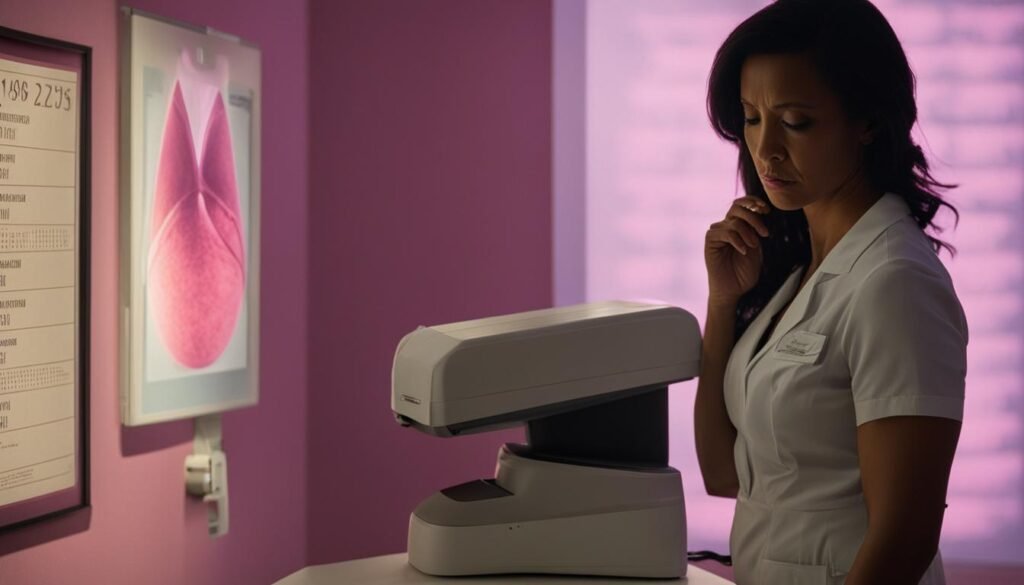
Did you know that about 1 in 8 women in the United States will develop breast cancer in their lifetime? It’s a startling statistic that highlights the importance of early detection and understanding the key symptoms of this disease.
Recognizing the early signs of breast cancer is crucial for timely diagnosis and effective treatment. By being aware of these symptoms, women can take proactive steps to protect their health and increase their chances of successful outcomes.
Importance of Mammograms in Early Detection
Mammograms are a critical tool in the early detection of breast cancer. By using low-dose X-rays, mammograms can detect tumors in the breast that are too small to be felt or seen visually. This early detection allows for prompt intervention and more effective treatment, significantly improving the chances of a positive outcome.
Regular mammograms, along with self-examination and awareness of breast changes, play a vital role in identifying breast cancer at its earliest and most treatable stage. Mammograms can detect tumors as small as 1 mm, making them a powerful screening tool for early diagnosis and prevention.
Why are mammograms important?
Mammograms are essential for several reasons:
- Early detection: Mammograms can detect breast cancer before any symptoms become evident. This allows for timely diagnosis and treatment, increasing the chances of successful outcomes.
- Precise diagnosis: Mammograms provide detailed images of the breast tissue, allowing radiologists to identify abnormalities that may be indicative of breast cancer.
- Monitoring: Regular mammograms create a baseline for comparison, enabling healthcare providers to track any changes in breast tissue over time, helping to identify potential concerns.
It is important to note that while mammograms are highly effective, they are not infallible. False-positive results, where mammograms detect abnormalities that turn out to be noncancerous, can occur. False-negative results, where mammograms fail to detect cancer, can also occur. Therefore, it is crucial to combine mammograms with other screening methods and maintain regular follow-ups with healthcare professionals.
Mammograms are recommended as part of routine breast cancer screening for women starting at the age of 40. However, screening recommendations may vary based on individual factors, such as family history and personal risk. Consult with your healthcare provider to determine the appropriate screening schedule for you.
Remember, early detection is key in the fight against breast cancer. By prioritizing regular mammograms, you are taking an active step towards protecting your breast health and ensuring the best chances for early diagnosis and successful treatment.
Non-Invasive Breast Cancer Symptoms
Non-invasive breast cancer refers to early-stage cancers that have not spread beyond the original site in the breast. Two common types of non-invasive breast cancer are ductal carcinoma in situ (DCIS) and lobular carcinoma in situ (LCIS). Unlike invasive breast cancer, non-invasive breast cancer often does not present noticeable physical symptoms.
DCIS is a type of breast cancer that is confined to the milk ducts and has not spread into surrounding tissues. It is typically detected through a mammogram, which can reveal small clusters of abnormal cells in the breast ducts. DCIS is considered a non-invasive form of breast cancer because the abnormal cells have not yet invaded the surrounding tissue.
LCIS is another type of non-invasive breast cancer that originates in the milk-producing lobules of the breast. Unlike DCIS, LCIS is usually found incidentally during a biopsy for another reason, such as a benign breast condition. LCIS is often regarded as a marker or risk factor for developing invasive breast cancer in the future, rather than an immediate cause for concern.
Both DCIS and LCIS are typically very small in size and do not cause significant symptoms. In fact, they are often identified through routine screening mammograms or during the investigation of other breast-related concerns. The absence of noticeable physical symptoms can make it challenging to detect non-invasive breast cancer without the use of imaging techniques or biopsy.
While non-invasive breast cancer may not present obvious symptoms, its detection through screening mammograms or biopsy is crucial for early intervention and appropriate management. Early diagnosis allows for prompt treatment, which can help prevent the progression of non-invasive breast cancer to invasive stages.
Invasive Breast Cancer Symptoms
Invasive breast cancer occurs when cancer cells spread from the original site in the breast to other tissues. It is the most common type of breast cancer, accounting for about 70-80% of all cases. Recognizing the symptoms of invasive breast cancer is crucial for early detection and effective treatment.
Common symptoms of invasive breast cancer include:
- A lump or mass in the breast: This is often the first noticeable sign of breast cancer. It may feel firm or hard, and it is usually painless.
- Breast swelling: The affected breast may appear larger than the other breast due to the growth of the tumor.
- Skin irritation or dimpling: The skin on the breast may become red, swollen, or pitted, resembling an orange peel.
- Breast or nipple pain: Some individuals may experience pain or discomfort in the breast or nipple.
- Nipple retraction: The nipple may turn inward or become flattened.
- Changes in nipple or breast skin: The skin may become scaly, thickened, or develop ulcers.
- Nipple discharge: A spontaneous discharge, such as blood or clear fluid, from the nipple.
- Swollen lymph nodes under the arm: Invasive breast cancer can cause lymph nodes under the arm to enlarge and become tender.
It is important to note that the symptoms of invasive breast cancer may vary depending on the specific type and stage of the cancer. For example, invasive ductal carcinoma (IDC) is the most common type of invasive breast cancer and often presents with a firm, irregularly shaped lump. Invasive lobular carcinoma (ILC), on the other hand, may cause subtle changes in breast shape and density without a distinct lump.
Early detection is key in improving breast cancer outcomes. If you experience any of these symptoms or notice any changes in your breasts, it is essential to consult with a healthcare professional for further evaluation. Remember, not all breast changes or lumps are cancerous, but it is always better to be safe and get a proper diagnosis.
Invasive breast cancer symptoms should never be ignored. Early detection can save lives and improve treatment outcomes.

| Type of Invasive Breast Cancer | Main Symptoms |
|---|---|
| Invasive Ductal Carcinoma (IDC) | A firm lump or mass in the breast, breast pain, nipple discharge, nipple retraction, skin changes |
| Invasive Lobular Carcinoma (ILC) | Changes in breast shape or density, nipple retraction, skin changes, breast pain |
Inflammatory Breast Cancer Symptoms
Inflammatory breast cancer (IBC) is a rare and aggressive form of breast cancer that requires prompt medical attention due to its distinctive symptoms. Unlike other types of breast cancer, IBC often does not cause a distinct lump. Instead, it presents with a combination of symptoms that can indicate a more advanced stage of the disease.
Inflammatory breast cancer symptoms can include:
- Red, swollen, and itchy breasts
- Breasts that are tender to the touch
- Changes in breast texture resembling an orange peel
- Heaviness or aching in the breast
- Inverted nipple
- Swollen lymph nodes
- Persistent symptoms that do not resolve with antibiotics
These symptoms may rapidly progress over a short period of time and can be accompanied by other warning signs of breast cancer, such as nipple discharge or changes in breast size or shape.
If you experience any of these inflammatory breast cancer symptoms, it is essential to seek immediate medical attention for a proper diagnosis and treatment plan. Early detection and intervention are crucial in managing inflammatory breast cancer effectively.
Other Types of Breast Cancer Symptoms
While the most common symptoms of breast cancer include lumps, skin changes, and nipple discharge, there are other types of breast cancer that may have distinct symptoms. It’s important to be aware of these symptoms and seek medical attention if any concerns arise. In this section, we will explore the symptoms of papillary carcinoma, angiosarcoma of the breast, phyllodes tumors, and male breast cancer.
Papillary Carcinoma Symptoms
Papillary carcinoma is a rare type of breast cancer that forms in the milk ducts and can present with a specific set of symptoms. These may include:
- A cyst or lump in the breast
- Nipple discharge, which may be clear or bloody
Angiosarcoma of the Breast Symptoms
Angiosarcoma is a rare and aggressive form of breast cancer that develops in the blood vessels of the breast. Symptoms of angiosarcoma may include:
- Changes to the skin of the breast, such as redness or bruising
- Swelling or a mass in the breast
- Lymphedema, which is swelling in the arm or chest
Phyllodes Tumor Symptoms
A phyllodes tumor is a rare type of breast tumor that forms in the connective tissue of the breast. While many phyllodes tumors are benign, some can be cancerous. Symptoms of phyllodes tumors may include:
- A palpable lump or breast mass
- Growth of the lump over time
- Skin changes, such as dimpling or puckering
Male Breast Cancer Symptoms
While breast cancer is much rarer in men, it does occur. Male breast cancer symptoms can be similar to those in women and may include:
- A lump or thickening in the breast or chest area
- Changes to the nipple or breast skin, such as redness or scaling
- Nipple discharge, which may be clear, bloody, or pus-like
It’s important to remember that the presence of these symptoms does not necessarily indicate breast cancer, but it’s crucial to have any concerns evaluated by a healthcare professional. Early detection and diagnosis are key to successful treatment outcomes.

What to Look for and When to Seek Medical Attention
When it comes to breast health, it’s crucial to be aware of the warning signs of breast cancer and know when to seek medical attention. By recognizing these signs early, we can increase the chances of a successful treatment outcome. Here are the key warning signs to look out for:
- New lumps or masses: If you notice any new lumps or masses in your breasts, it’s essential to get them checked by a healthcare professional. While not all lumps are cancerous, it’s important to rule out any potential risk.
- Breast or nipple pain: Persistent pain, soreness, or discomfort in the breasts or nipples should be evaluated by a healthcare provider. Although less common, breast pain can be a sign of breast cancer.
- Skin changes: Pay attention to any changes in the skin of your breasts, such as redness, swelling, puckering, or dimpling. These changes may indicate an underlying issue that requires medical attention.
- Nipple retraction: If your nipple suddenly becomes inverted or retracted, it’s important to have it examined by a healthcare professional. Nipple changes can be a sign of breast cancer.
- Nipple discharge: While some nipple discharge is normal, unexpected discharge that is bloody, clear and sticky, or appears spontaneously without stimulation should be evaluated by a doctor.
- Changes in breast size or shape: If you notice any unexplained changes in the size or shape of your breasts, it’s important to have them checked. Breast asymmetry or sudden changes may indicate an underlying issue.
- Persistent symptoms: If you experience any persistent symptoms in your breasts that don’t go away over time, it’s crucial to seek medical attention. Persistent symptoms should never be ignored.
If you’ve completed treatment for breast cancer, it’s important to be vigilant for signs of recurrence. Recurrence can happen even after successful treatment, so staying aware of your body is crucial. Here are some signs of breast cancer recurrence to be mindful of:
- New lumps or masses: Any new lumps or masses in the treated breast or the surrounding area should be evaluated by a healthcare professional.
- Swelling or redness: Unexplained swelling or redness in the treated breast may be a sign of recurrence.
- Persistent pain: Ongoing or worsening pain in the treated breast should be assessed by a medical professional.
- Changes in the surgical site: Keep an eye out for any changes in the appearance or feel of the surgical scar or treated area.
- Unexplained fatigue or weight loss: If you experience persistent fatigue or unexplained weight loss, it’s essential to consult with your healthcare team.
Remember, if you notice any of these warning signs or have concerns about your breast health, it’s always better to seek medical attention. Your healthcare provider can conduct the necessary tests and provide you with an accurate diagnosis. Early detection and prompt treatment can significantly improve the chances of successful outcomes.
| Warning Signs | When to Seek Medical Attention |
|---|---|
| New lumps or masses | If you notice any new lumps or masses, it’s essential to get them checked by a healthcare professional. |
| Breast or nipple pain | Persistent pain, soreness, or discomfort in the breasts or nipples should be evaluated by a healthcare provider. |
| Skin changes | Pay attention to any changes in the skin of your breasts, such as redness, swelling, puckering, or dimpling. |
| Nipple retraction | If your nipple suddenly becomes inverted or retracted, it’s important to have it examined by a healthcare professional. |
| Nipple discharge | While some nipple discharge is normal, unexpected discharge that is bloody, clear and sticky, or appears spontaneously without stimulation should be evaluated by a doctor. |
| Changes in breast size or shape | If you notice any unexplained changes in the size or shape of your breasts, it’s important to have them checked. |
| Persistent symptoms | If you experience any persistent symptoms in your breasts that don’t go away over time, it’s crucial to seek medical attention. |
Understanding Normal Breast Variations and Breast Health
When it comes to breast health, it’s important to understand that every woman’s breasts are unique. Normal breast variations include lumpy or uneven textures, which are often harmless and not indicative of any medical condition. These variations can be influenced by various factors, such as hormonal changes during menstrual cycles, pregnancy, weight fluctuations, and medication use.
To maintain breast health, it’s essential to be familiar with the normal look and feel of your breasts. By regularly examining your breasts, you can detect any changes that may occur over time. If you notice any unusual changes, it’s important to consult with a healthcare professional for further evaluation and guidance.
The Importance of Regular Breast Screenings
Regular breast screenings, including mammograms, play a vital role in maintaining breast health and detecting any potential abnormalities at an early stage. Mammograms are recommended for women starting at a certain age, as determined by their healthcare provider. These screenings can detect small changes in breast tissue that may indicate the presence of breast cancer or other conditions.
By undergoing regular breast screenings, you can have peace of mind knowing that your breast health is being monitored and any potential issues can be addressed promptly. Early detection is key to successful treatment and improved outcomes in cases of breast cancer.
“Regular breast screenings are essential for early detection and maintaining breast health. By staying proactive and being aware of any changes in your breasts, you can take control of your breast health and ensure timely medical intervention if needed.”
Importance of Breast Cancer Centers in Diagnosis and Treatment
Breast cancer centers play a critical role in the diagnosis and treatment of individuals facing breast cancer. These specialized centers are staffed by multidisciplinary teams of medical professionals who are experts in breast cancer care. At our breast cancer center, we provide comprehensive care and personalized treatment plans to meet the unique needs of each patient.
Our breast cancer center offers a wide range of services, including state-of-the-art diagnostic tools and advanced treatment options. We use cutting-edge technology and techniques to accurately diagnose breast cancer and determine the most appropriate treatment approach. Our team of specialists collaborates closely to develop individualized treatment plans that may include surgery, radiation therapy, chemotherapy, targeted therapies, and hormone therapy.
In addition to diagnosis and treatment, our breast cancer center is committed to providing supportive care to patients throughout their journey. We understand that navigating breast cancer can be emotionally and physically challenging, and our team is here to offer guidance, education, and support. We prioritize integrating care services to ensure seamless coordination and improve treatment outcomes while minimizing side effects.
When facing breast cancer, it’s essential to seek care from a specialized breast cancer center. Our dedicated team is here to provide you with expert care, personalized treatment plans, and comprehensive support. We are committed to helping you achieve the best possible outcomes on your breast cancer journey. Contact us today to schedule a consultation and learn more about our services.